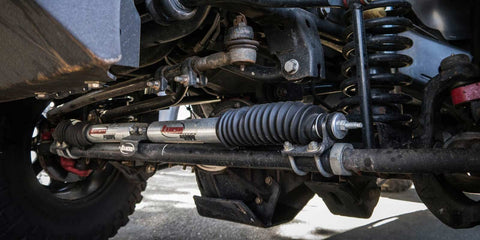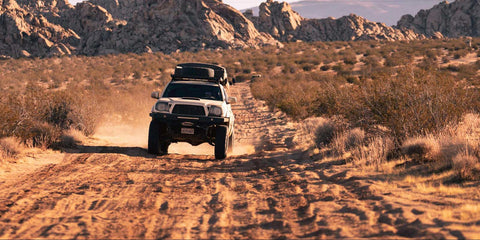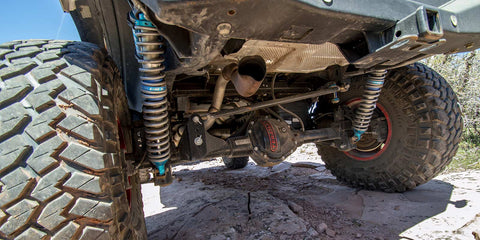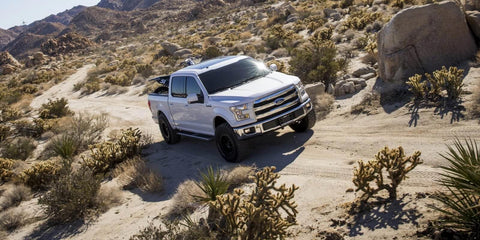Internal vs External Bypass Shock Absorbers
Posted by Sean Reyes on
What is an Internal Bypass Shock?
In a some cases, such as the King Shocks IBP shocks, there are cutouts from the active piston in the shock to allow the shock oil to flow through the valving (or shim stacks), in which case the oil then meets resistance on a secondary piston to activate the primary damping mechanism. This allows a certain amount of oil flow to occur without much resistance, which is usually specifically tuned for soft comfort in a certain ride zone.
Other shock designs with Internal Bypass, such as Old Man Emu BP-51 shocks, there are cutouts along the internal shock tube, which allows the oil to flow freely through as the main piston is moving through the chamber. So when the piston is meeting resistance through the oil, a certain amount is allowed to go ‘around’ the piston, through the tube cutouts, and circulate to the other side of the chamber. This achieves similar results of less resistance in the optimized ride zone.
What is an External Bypass Shock?
These are the high end race shocks that are featured on many trophy trucks and race vehicles, where there is sometimes a dizzying amount of tubes on the main shock body. Most of these tubes, if not all, will feature an adjustment valve, that limits the flow of shock oil through the tube.
The placement of the external tubes are specific to certain ride zones in the shock, this is why there are tubes closer to the middle, and tubes at the very ends of the shock. By limiting or increasing oil flow in these zones, you are able to tune a shock for certain speeds over a given terrain. This is why a truck’s wheels sometimes are floating / bouncing very consistently in a given zone when the truck is at a consistent pace. A lot of the oil is being allowed to bypass the main shock pistons in the middle ride zone, and when that piston hits the next zone is when the damping significantly increases to keep suspension in the preferred zone.
Major Differences between Internal and External Bypass
Package size, capability, longevity, speed; all of these are major factors in determining what kind of shock you’re going to need for the vehicle. Unless its a race vehicle that needs top-tier performance, an external bypass setup is overkill most of the time. There are new additions to the aftermarket suspension industry that are changing that point of view though, as compact external packages are now being made available for vehicles like the Tacoma, 4Runner, Wrangler, and Raptor.
An internal bypass setup is an excellent option for a trail rig that isn’t seeing high speed desert scenarios, and usually sitting in the middle 75% of the shock ride zone during their travels. Internal Bypass aims to achieve good comfort over 95% of your driving, allowing the middle ride zone to be soft and plush, while increasing damping in the very end ranges of compression and rebound cycles to keep the vehicle under control and the tires on the ground.
An external bypass setup is the go-to option when your chosen off-road terrain can vary greatly from use to use. For example, you can have a 3-tube or 4-tube bypass shock that can be tuned specifically for Race1, which doesn’t feature 3-foot whoops and obstacles, so the bypass tubes can allow that vehicle to travel faster over most of the terrain without worrying about severe top out or bottom out actions. Then when its time for Race2, the same shock can be tuned in order for slightly slower speeds, and to control the extreme action of top out and bottom out control.
A specific use case for both of these shock designs are the Old Man Emu BP-51 Internal Bypass and the Bilstein 8100 External Bypass, both of which feature rebound and compression damping adjustment.
- The Bilstein comes with a 60mm active internal piston, while the Old Man Emu comes with a 51mm internal piston.
- The Old Man Emu shock package is significantly more compact than the Bilstein, the BP-51 shocks can fit in more places compared to the 8100, since there are no external tubes to worry about.
- The larger piston size of the 8100 means a little more consistent damping response to terrain, lower shaft velocity, lower operating pressures, which all translate to faster off-road capability and longevity.
- The internal bypass of the BP-51, more compact package, equate to weight and materials savings, and a much less expensive package, while achieving excellent road comfort mixed with the adjustability needed to handle varying weight loads and terrains.









